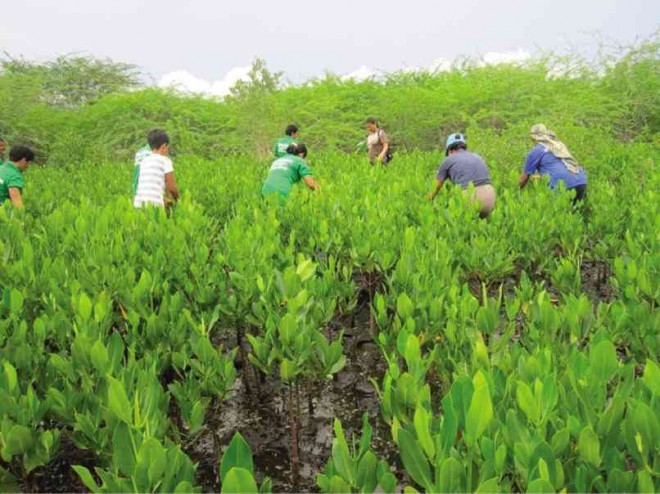Hope also grows in mangrove project

RESIDENTS inspect the mangrove areas in the island town of Panukulan, Quezon province. QUEZON ENVIRONMENT AND NATURAL RESOURCES OFFICE/CONTRIBUTED PHOTO
Two years after the planting of two million mangrove propagules in Quezon province, signs of a promising future to fishermen and coastal residents are now showing.
“Our fishermen, particularly the marginalized, are excited when marine lives start to appear at the mangrove sites,” Manny Calayag, deputy head of the Quezon-Environment and Natural Resources Office (Quezon-Enro), said in an interview.
Mangrove forests, also known as the “rainforests of the sea,” are an important part of the marine ecosystem as the roots of the trees provide shelter for marine life while their fallen leaves become feed for fish and other marine animals.
Calayag said the mangrove growing sites in different parts of the province had trees that are more than five feet tall. He attributed the feat to the people who take care of the trees.
Education campaign
“The people now realize the importance of mangroves to their safety and livelihood,” he said.
The widespread information and education campaign has paid off, he said, with more fishermen now seeking government support to acquire fishing boats and equipment.
On June 30, 2012, Gov. David Suarez led thousands of volunteers in planting more than two million mangrove propagules in a single day along the province’s 1,066-kilometer coastline to rehabilitate its coast from years of natural and manmade destruction.
Thirty-four of Quezon’s 42 towns are coastal: 17 along Lamon Bay in the Pacific Ocean; 12 in Tayabas Bay facing the China Sea; and 5 in Ragay Gulf.
‘Beach forests’
The mangrove planting project also transformed these areas into “beach forests” that help shield inland communities from storms and sea surges, Calayag said.
In most parts of the province, cutting of mangrove for charcoal and fishpond expansion has stopped due to strict enforcement of environmental laws by the Department of Environment and Natural Resources, and the local and provincial governments, he said.
Cutting of mangrove trees is banned by Presidential Decree No. 705 (Forestry Code of the Philippines) and Republic Act No. 8550 (Philippine Fisheries Code). The provincial board, through a resolution, prohibits charcoal making using wood products as a way of protecting mangrove areas and their fragile forest.
But challenges remain, Calayag said, noting how newly planted mangroves along the Tayabas Bay continued to die due to the presence of plastic materials washed ashore, particularly in coastal areas off Lucena and the towns of Sariaya and Pagbilao.
“Plastic (materials) that were washed ashore wrapped around the propagules and suppressed their growth,” he said.
People still throw plastic trash into the sea despite the ban on plastic use in most Quezon towns, he added.
Strong waves also destroyed some of the mangroves, prompting another planting activity to replace those that had died, Calayag said.














